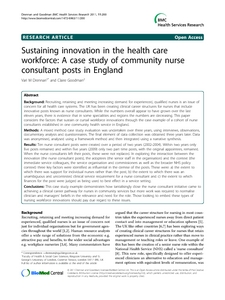Drennan, VM; Goodman, C
(2011)
Sustaining innovation in the health care workforce: A case study of community nurse consultant posts in England.
BMC HEALTH SERVICES RESEARCH, 11 (200).
ISSN 1472-6963
https://doi.org/10.1186/1472-6963-11-200
SGUL Authors: Drennan, Vari MacDougal
![[img]](https://openaccess.sgul.ac.uk/2052/1.hassmallThumbnailVersion/1472-6963-11-200.pdf)  Preview |
|
["document_typename_application/pdf; charset=binary" not defined]
Published Version
Download (745kB)
| Preview
|
Abstract
BACKGROUND: Recruiting, retaining and meeting increasing demand for experienced, qualified nurses is an issue of concern for all health care systems. The UK has been creating clinical career structures for nurses that include innovative posts known as nurse consultants. While the numbers overall appear to have grown over the last eleven years, there is evidence that in some specialities and regions the numbers are decreasing. This paper considers the factors that sustain or curtail workforce innovations through the case example of a cohort of nurse consultants established in one community health service in England.
METHODS: A mixed method case study evaluation was undertaken over three years, using interviews, observations, documentary analysis and questionnaires. The final element of data collection was obtained three years later. Data was anonymised, analysed using a framework method and then integrated using a narrative synthesis.
RESULTS: Ten nurse consultant posts were created over a period of two years (2002-2004). Within two years only five posts remained and within five years (2009) only two part time posts, with the original appointees, remained. When the nurse consultants left their posts, these were not replaced. In exploring the interaction between the innovation (the nurse consultant posts), the adoptees (the senior staff in the organisation) and the context (the immediate service colleagues, the service organisation and commissioners as well as the broader NHS policy context) three key factors were identified as influential in the demise of the posts. These were: a) the extent to which there was support for individual nurses rather than the post, b) the extent to which there was an unambiguous and uncontested clinical service requirement for a nurse consultant and c) the extent to which finances for the post were judged as being used to best effect in a service setting.
CONCLUSIONS: This case study example demonstrates how tantalisingly close the nurse consultant initiative came to achieving a clinical career pathway for nurses in community services but more work was required to normalise clinician and managers' beliefs in the relevance and need for the role. Those looking to embed these types of nursing workforce innovations should pay due regard to these issues.
| Item Type: |
Article
|
| Additional Information: |
PubMed ID: 21854634
© 2011 Drennan and Goodman; licensee BioMed Central Ltd. This is an Open Access article distributed under the terms of the Creative Commons Attribution License (http://creativecommons.org/licenses/by/2.0), which permits unrestricted use, distribution, and reproduction in any medium, provided the original work is properly cited. |
| Keywords: |
Career Mobility, Community Health Services, Diffusion of Innovation, England, Humans, Interviews as Topic, Nurse's Role, Nurses, Organizational Case Studies, Questionnaires, Referral and Consultation, Science & Technology, Life Sciences & Biomedicine, Health Care Sciences & Services, PROFESSIONAL CONSULTANTS |
| Journal or Publication Title: |
BMC HEALTH SERVICES RESEARCH |
| ISSN: |
1472-6963 |
| Related URLs: |
|
| Dates: |
| Date | Event |
|---|
| 20 August 2011 | Published |
|
| Web of Science ID: |
WOS:000294736000001 |
  |
Download EPMC Full text (PDF)
|
 |
Download EPMC Full text (HTML)
|
| URI: |
https://openaccess.sgul.ac.uk/id/eprint/2052 |
| Publisher's version: |
https://doi.org/10.1186/1472-6963-11-200 |
Statistics
Item downloaded times since 01 May 2012.
Actions (login required)
 |
Edit Item |



